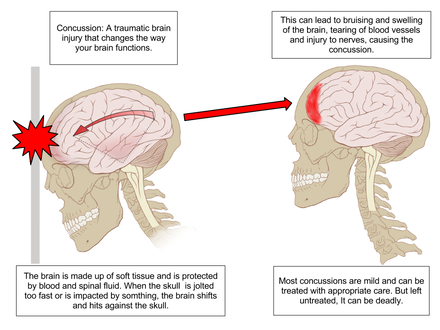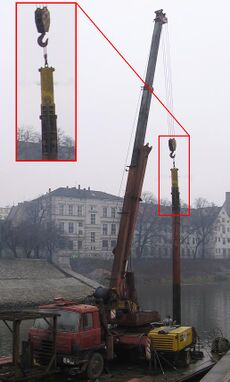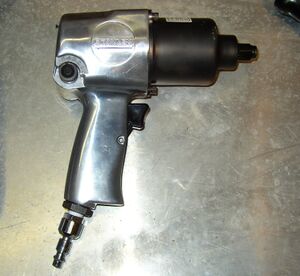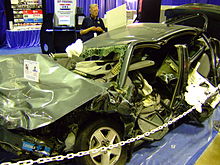صدم (خواص المواد)
قوة الصدم إنگليزية: Impact force هي قوة أو صدمة عالية مطبقة خلال زمن قصير جداً. حيث يعتبر تأثير هذه القوى أشد من تأثير القوى الساكنة التي تؤثر لفترات طويلة نسبياً.
في السرعات العادية، و في ظروف التصادم غير المرن، فإن الجسم المصدوم بقذيفة سوف يتشوه، وهذا التشوه سوف يمتص معظم أو كامل طاقة التصادم. انطلاقاً من مبدأ مصونية الطاقة، فإن الطاقة الحركية للقذيفة سوف تتحول إلى طاقة حرارية و صوتية نتيجة للتشوهات و الاهتزازات الحاصلة في الجسم المصدوم. مع العلم أن هذه التشوهات و الاهتزازات لا تحدث آنياً.
عند سرعات الصدم العالية، لا يوجد وقت كافي لحدوث التشوهات و الاهتزازات، في هذه الحالة تبدو المادة على أنها أكثر هشاشة مما هي عليه، وتمتص معظم الطاقة المطبقة عليها لكي تتحطم.
. . . . . . . . . . . . . . . . . . . . . . . . . . . . . . . . . . . . . . . . . . . . . . . . . . . . . . . . . . . . . . . . . . . . . . . . . . . . . . . . . . . . . . . . . . . . . . . . . . . . . . . . . . . . . . . . . . . . . . . . . . . . . . . . . . . . . . . . . . . . . . . . . . . . . . . . . . . . . . . . . . . . . . . .
التطبيقات
- عادة ما يتم طرق المسمار بعدة ضربات بواسطة مطرقة، سرعة الطرق العالية تمنع قوى احتكاك الخشب مع المسمار من إعاقة حركته إلى الأمام.
- آلية تثبيت الأساسات (Pile driver) ، حيث تعتمد نفس المبدأ السابق لكن بمقياس أكبر.
- آلية فك و تثبيت البراغي، أداة مماثلة لما سبق، مصممة بحيث يتم تطبيق عزم فجائي خلال زمن قصير جداً لتثبيت أو فك البراغي . حيث أن عملية الفك و التثبيت عند السرعات العادية تؤدي إلى ضياع العزم المطبق نتيجة الاحتكاك الحاصل في الأسنان المعشقة، إلا العزم المطبق عند السرعات العالية يؤدي إلى تحريك البرغي قبل أن تحدث أية ضياعات.
- في مجال المقذوفات، فإن الرصاص يعتمد مبدأ الصدم لاختراق السطوح المقاومة للقوى الكبيرة. حيث أن قطعة المطاط على سبيل المثال تسلك سلوك الخشب عندما تخترقها رصاصة،إذ تتمزق دون أن تمتط أو تهتز.
الصدمات المسببة لضرر

Road traffic accidents usually involve impact loading, such as when a car hits a traffic bollard, water hydrant or tree, the damage being localized to the impact zone. When vehicles collide, the damage increases with the relative velocity of the vehicles, the damage increasing as the square of the velocity since it is the impact kinetic energy (1/2 mv2) which is the variable of importance. Much design effort is made to improve the impact resistance of cars so as to minimize user injury. It can be achieved in several ways: by enclosing the driver and passengers in a safety cell for example. The cell is reinforced so it will survive in high speed crashes, and so protect the users. Parts of the body shell outside the cell are designed to crumple progressively, absorbing most of the kinetic energy which must be dissipated by the impact.
Various impact test are used to assess the effects of high loading, both on products and standard slabs of material. The Charpy test and Izod test are two examples of standardized methods which are used widely for testing materials. Ball or projectile drop tests are used for assessing product impacts.
The Columbia disaster was caused by impact damage when a chunk of polyurethane foam impacted the carbon fibre composite wing of the space shuttle. Although tests had been conducted before the disaster, the test chunks were much smaller than the chunk that fell away from the booster rocket and hit the exposed wing.
When fragile items are shipped, impacts and drops can cause product damage. Protective packaging and cushioning help reduce the peak acceleration by extending the duration of the shock or impact.[2]
انظر أيضاً
- Charpy impact test
- Coefficient of restitution
- Compression (physical)
- Cushioning
- Fall factor
- Impact driver
- Impact sensor
- Impact wrench
- Impulse (physics)
- Izod impact strength test
- Jerk (physics)
- Road traffic accident
- Shock
- Shock data logger
- Tension (physics)
- Write-off
الهامش
- ^ Consumer Product Safety Commission. "Safety Standard for Bicycle Helmets" (PDF). Final Rule 16 CFR Part 1203. Archived from the original (PDF) on 24 September 2006. Retrieved 3 December 2014.
- ^ Package Cushioning Design. MIL-HDBK 304C. DoD. 1997.
المصادر
- Goldsmith, W. (1960). Impact: The Theory and Physical Behaviour of Colliding Solids Dover Publications, ISBN 0-486-42004-3
- Poursartip, A. (1993). Instrumented Impact Testing at High Velocities, Journal of Composites Technology and Research, 15(1).
- Toropov, AI. (1998). Dynamic Calibration of Impact Test Instruments, Journal of Testing and Evaluation, 24(4).



